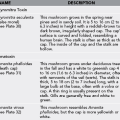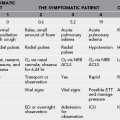Burns and Smoke Inhalation
Thermal burns are classified into minor, moderate, and major, largely based upon burn depth and size in proportion to the patient’s total body surface area (TBSA). Burn size can be calculated by the “rule of nines.” Each upper extremity accounts for 9% TBSA, each lower extremity accounts for 18%, the anterior and posterior trunk each account for 18%, the head and neck account for 9%, and the perineum accounts for 1% (Fig. 7-1). Children less than 4 years old have much larger heads and smaller thighs in proportion to body size than do adults. In an infant, the head accounts for approximately 18% of the TBSA; body proportions do not fully reach adult percentages until adolescence. For smaller burns, an accurate assessment of burn size can be made by using the patient’s hand. The entire palmar surface of the hand, fingers included, represents 1% TBSA. Reassessment of burn size and depth is important, particularly early in the management of burn patients, because the extent of injury may not be initially apparent.
General Treatment
1. Remove the patient from the source of the burn.
a. If clothing is on fire, roll the patient on the ground or wrap him or her in a blanket to extinguish the flames.
b. Any hot or burned clothing, jewelry, and obvious debris should immediately be removed to prevent further injury and enable accurate assessment of the extent of burns.
c. If the burn is chemical, use large amounts of water (minimum 10 minutes of active rinsing) to wash off the agent(s). Do not apply a specific neutralizing agent, which may generate heat and worsen the injury.
d. If the eyes are involved, copiously irrigate them.
e. Because phosphorus ignites on contact with air, keep any phosphorus still in contact with the patient’s skin covered with water.
2. Perform a primary and secondary survey. Evaluate the airway for smoke inhalation. If present, administer oxygen by face mask, 5 to 10 L/min, and transport the patient to a medical facility (see Smoke Inhalation and Thermal Airway Injury, later). Be alert for vomiting into the face mask.
3. Treat burns by rapidly applying cool water (1° to 5° C [33.8° to 41° F]) for about 30 minutes. Local cooling of less than 10% of TBSA can be continued longer than 30 minutes to relieve pain; however, prolonged cooling of a larger TBSA burn may cause hypothermia and macerate skin. Cooling has no therapeutic benefit, other than pain control, if delayed more than 30 minutes after the burn injury.
4. Remove any jewelry from burned areas, fingers, and toes.
5. Update tetanus immunization as soon as possible.
6. Immediate evacuation to a burn center should be arranged when injuries meet the criteria for major burns (see later).
Burn Classification
Superficial Burn (First-Degree Burn)
Treatment
1. Immediately cool the burn with cold water or wet compresses. Do not use ice directly on skin.
2. Apply aloe vera gel or lotion in concentrations of at least 60% topically to the burn. Aloe vera has antimicrobial properties and is an effective analgesic.
3. Administer ibuprofen, aspirin, or another nonsteroidal antiinflammatory drug. An adult dose is ibuprofen 800 mg q8h for 48 hours.
Superficial Partial-Thickness Burn (Second-Degree Burn)
1. It involves the upper layer of dermis and creates clear fluid-filled blisters.
2. Blisters may not appear until several hours after injury.
3. When blisters are removed, the skin is moist and erythematous, blanches with pressure, and is hypersensitive to touch.
4. If infection is prevented, the burn heals spontaneously within 3 weeks without functional impairment.
Deep Partial-Thickness Burn (Second-Degree Burn)
1. Damage to hair follicles and sweat glands.
2. Blisters form, but the wound surface is usually mottled pink and white immediately after injury or may be dry with a cherry-red appearance.
3. Wound is possibly less sensitive to touch than surrounding normal skin. The patient complains of discomfort rather than pain.
4. When pressure is applied to the burn, capillary refill returns slowly or is absent.
5. If infection is prevented, the burn heals in 3 to 9 weeks with scar formation.
Treatment
1. Irrigate gently with cool water or saline solution to remove all loose dirt and loose, devitalized skin. Wash the burn gently with plain soap and water, and gently dry with a clean towel. Wash water should be suitable for drinking (e.g., disinfected) but does not need to be sterile or bottled.
2. Peel off or trim any necrotic skin with sharp debridement.
3. Drain large (>2.5 cm [1 inch]), thin, fluid-filled blisters, and trim the dead skin if a sterile dressing can be applied.
4. Leave small, thick blisters intact.
5. Apply a topical chemotherapeutic agent to the wound. Commonly used topical agents include bacitracin, Neosporin, Polysporin, and double- or triple-antibiotic ointment. Silver sulfadiazine is a widely used agent because it is soothing to the wound, has a good antimicrobial spectrum, and has almost no systemic absorption or toxicity. The patient should be questioned about allergy to sulfa drugs before their use, because allergic reactions are encountered in about 3% of patients. If a commercial agent is not available, honey can also be used. Topical butter for burns is not recommended.
6. Cover the burn with a nonadherent dressing such as Telfa or Adaptic, and change the dressing at least once per day. Other dressings (hydrogels, silver-coated dressings, silicone gel sheets, calcium alginate) designed to minimize the frequency of dressing changes and promote healing are available but are not necessary and are more expensive. No dressing has been shown conclusively to accelerate the healing of burn wounds. The dressing should cover the entire burned area, leaving no burned skin exposed to air, and should not limit the patient’s ability to actively flex and extend all burned extremities and digits.
7. Patients with burns that involve less than 10% TBSA generally do not require fluid resuscitation. They should stay well hydrated but should not be encouraged to force fluids. Patients with burns that involve 10% to 20% TBSA usually do not require intravenous (IV) fluid resuscitation. They should be encouraged to drink fluids that contain electrolytes. Hydration status in these patients should be monitored by ensuring that the oral mucous membranes are moist and that urine output is normal (at least 1 mL/kg/hr) with light-colored urine.
8. Patients with burns that involve more than 20% TBSA should receive IV fluid resuscitation with crystalloid solution (normal saline or lactated Ringer’s solution) if available until they reach a medical facility. Because of the high incidence of septic thrombophlebitis, lower extremities should be avoided as IV portals. Upper extremities are preferable, even if the IV line must pass through burned skin.
a. Administer 4 mL/kg/% TBSA/24 hr. Half the calculated 24-hour fluid total is given over the first 8 hours from the time the burn occurred (not the time the IV line was established). The second half is infused over the remaining 16 hours. The rate should be adjusted to support the patient’s vital signs and maintain a urine output of at least 1 mL/kg/hr.
b. Intraosseous infusion of fluids is useful when there is difficulty achieving a percutaneous IV line.
9. Avoid hypothermia in the patient by placing a clean sheet under the person and then covering with another clean sheet, followed by clean blankets.
10. Antibiotics should be administered only if the burn becomes infected.
a. Infection is manifested by pus, foul odor, cloudy blisters, increased redness and swelling in the normal skin around the burn, and fever greater than 38.3° C (101° F).
b. If an antibiotic is necessary, give dicloxacillin (adult dose 100 mg PO q12h) or cephalexin (adult dose 500 mg PO q6h).
11. Partial thickness burns can be excruciatingly painful. Administer pain medication such as hydrocodone/acetaminophen 5/325 (adult dose is 1 to 2 tablets PO q4-6 h prn) or oxycodone/acetaminophen 7.5/325 (adult dose is 1 to 2 tablets PO q6h prn).
Full-Thickness Burn (Third-Degree Burn)
1. Involves all layers of the dermis and can heal only by wound contracture, epithelialization from the wound margin, or skin grafting
2. Leathery, firm, depressed when compared with adjoining normal skin, and insensitive to light touch or pinprick
3. Rarely blanches with pressure; may have a dry, white (“waxy”) appearance with or without small clotted blood vessels that appear as purple or maroon lines under the surface. An immersion scald may have a red appearance, but it does not blanch with pressure
4. Can be difficult to differentiate from a deep partial-thickness burn
5. Develops classic burn eschar that separates from underlying viable tissue
Fourth-Degree Burn
Treatment
1. Follow the same instructions as for second-degree burn.
2. Immediate evacuation to a burn center is recommended.
3. Field considerations for fourth-degree burns are the same as for full-thickness burns.
4. Escharotomy of the neck or chest may be required if mechanical constriction from eschar prevents adequate respiration. Decompressive escharotomy of an extremity may be required for circumferential full-thickness burns if edema causes constriction and distal ischemia. Even in the wilderness, excharotomy should be performed if respiration is impaired or there is compromised distal perfusion. Escharotomy does not require an anesthetic. The burned area should be rinsed well and cleansed with soap and water. A scalpel is used to perform an incision through the eschar into the subcutaneous tissue. Ideally only the eschar is incised because subcutaneous fat is often viable and can cause bleeding. A “give” is felt as the scalpel passes through the eschar and into the fat. After the long initial incision is made, a short, push-type maneuver is performed by laying the belly of the scalpel blade along the entire length of the incision to ensure that all constricting tissue has been freed. A popping open of the incision occurs as the scalpel moves from one end of the incision to the other. For extremity escharotomy, the first incision is made along the lateral aspect of the extremity. The extremity should soften, and any signs or symptoms of ischemia should resolve within a few minutes. If this does not occur, a second incision should be made along the medial aspect of the extremity. On completion of the procedure, a moist dressing such as antibiotic/antiseptic cream or ointment should be applied. A compression wrap and elevation of the extremity after the procedure will assist in maintaining hemostasis.
Disposition
1. A burn less than 10% TBSA in adults and less than 5% in young or old (<10 or >50 years old) can be treated in a wilderness setting if adequate first-aid supplies are available and wound care is performed diligently. Exclusions are deep burns of the face, hands, feet, perineum, or circumferential burn of an extremity.
2. Patients with moderate burns should be admitted to a hospital. Moderate burns are defined as any of the following:
b. In young or old, 5% to 10% TBSA burn
c. Full-thickness burn of 2% to 5% TBSA
e. Suspected inhalation injury
g. Patient with medical problems predisposing to infection (e.g., diabetes, sickle cell disease, immunosuppression)
3. A major burn patient should be evacuated immediately to a burn center. A major burn is defined as any of the following:
Carbon Monoxide Poisoning
Signs and Symptoms
1. If resulting from a fire: dyspnea, burns of the mouth and nose, singed nasal hairs, sooty sputum, harsh cough
2. Headache, nausea, vomiting, tachypnea, dizziness, loss of manual dexterity
3. Sometimes subtle perception and memory abnormalities or frank confusion and lethargy
4. Unconsciousness leading to coma
6. Late complications (after first 48 hours): personality disorders, chronic headaches, seizures, Parkinson’s disease (generally after 2 to 40 days)
Smoke Inhalation and Thermal Airway Injury
Signs and Symptoms
2. Intraoral or pharyngeal burns
4. Soot in the mouth or nose, carbonaceous sputum
5. Hoarseness, inspiratory stridor with a barking sound that seems to originate in the neck, or expiratory wheezing
6. Shortness of breath and coughing that produces carbonaceous black sputum
Treatment
1. Once the injury has occurred, no measures can be taken to limit its progress, so evacuate the patient immediately.
2. Administer humidified 100% oxygen by a nonrebreather mask.
3. Consider initiating intubation and ventilation if stridor or dyspnea is present. Note that progressive edema can produce complete airway obstruction.
4. If the patient loses his or her airway, and intubation is not possible, perform immediate surgical cricothyroidotomy (see Chapter 10).
5. Administer a bronchodilator (albuterol, 200 to 400 mcg [2 to 8 full inhalations, depending on preparation] by metered-dose inhaler with a spacer q15-20 min prn).







